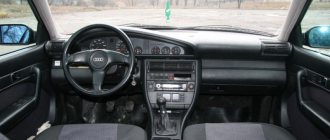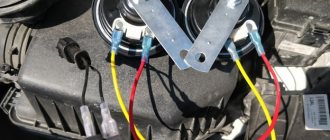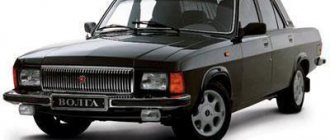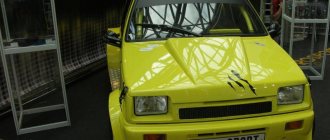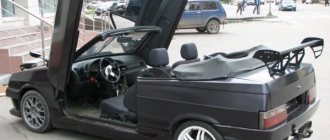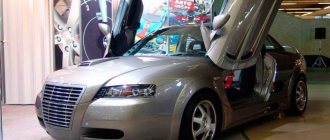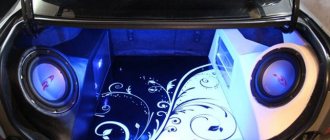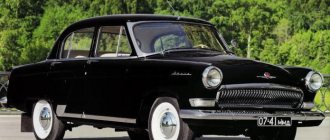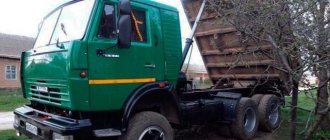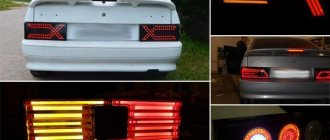Any car requires improvement and refinement, especially if it is produced at the ZAZ plant. Tuning the ZAZ-1102 “Tavria” is a modification of the famous Ukrainian car, which has received the status of a national car. Low cost, ease of repair and operation made it affordable even for people with low wages. But sadly, the price equals the quality, which is why many car enthusiasts do the tuning of the Tavria with their own hands.
External body kits
On the outside, almost all tuning parts are made manually and in-house. With the entry of the ZAZ-1103 into the market, many domestic manufacturers of parts began to produce lightweight body kits, but they do not provide aerodynamic qualities. Therefore, tuning the Tavria with your own hands has become more relevant.
The first step is to modify the front and rear bumpers. The materials can be plastic, fiberglass and automotive plasticine, which are easy to process and, after taking shape, hold it well.
Side sill trims are made of plastic or sheet metal; aluminum remains the best for production. Wheel arch extensions can be made from the same material, but here they usually use polyurethane foam, which is then puttied and painted.
You can install a rear window spoiler for the Tavria brand on the tailgate. A tuning version of the part can be purchased at automotive markets or in specialized stores.
Not produced for ZAZ-1102. But car enthusiasts have found a way out: they install cheap Chinese xenon in standard lenses - this is also tuning. "Tavria", a photo of which is presented in the article, with the entry of LED technology into the market, motorists began to receive standard headlights with the addition of running lights.
So, we decided - we take ours
But what to take so as not to make a mistake? There is an opinion that, for example, take the ZAZ-1102 “Tavria”
or
ZAZ-1103 “Slavuta”
is much more profitable than
“Zhiguli”.
And what?
Small-displacement engine of 1.1-1.3 liters,
consumes little gasoline.
It weighs less than the Lada, only 745 kg and 790 kg, respectively. Install the HBO
and ride, as they say, in the air!
Such a used car costs ridiculous money
, which in our case is one of the decisive factors.
ZAZ-1102 "Tavria"
Interior tuning
Since the price of the car is about 1000-2000 dollars, then for ZAZ Tavria tuning the interior becomes unprofitable, since the same money can be invested in the material itself. Motorists found an easier way out. Instead of standard seats, they are installed from Opel Vectra B. They fit perfectly onto standard mounts, and their cost on the automotive market is insignificant.
Tuning the Tavria's interior does not end with just replacing the seats. The upholstery of the pillars is replaced with carpet, the color of which is chosen by the owner himself. The instrument panel is covered with colored self-adhesive film, which is produced by the Kharkov Polyethylene Plant. The backlight of the instrument cluster is replaced by soldering LEDs into a digital circuit.
Engine tuning
For the Ukrainian car "Tavria" engine tuning exists in two options:
- Complete replacement of the internal combustion engine and gearbox with an engine from a VAZ-2106 or 2108.
- Refinement and injection.
The first option is quite familiar to many: the old MeMZ-245 motor is removed and a new one is installed. In this case, you will have to replace many parts along the way, from mounting pads to elements for modifying the fuel system and cooling.
The second option is also not quite as simple as it seems at first glance. The engine will have to be dismantled and subjected to boring and honing for new pistons. Usually, instead of standard ones, lightweight ones from the manufacturer ATI (Poland) with a diameter of 75 mm are installed.
The chamfer of the intake and exhaust valves of the Tavria car, tuning of which is done only on a special machine, is reduced by 0.4 mm, which makes it possible to inject fuel into the combustion chamber earlier. You can also install two Solex carburetors to add power. But it is worth considering that consumption will increase by 50% of the standard.
The last option to add power is to install an exhaust system kit. This is an expensive pleasure, and therefore the owners of the Ukrainian Tavria car do not tune this system. The only thing that remains affordable is the range of which is huge.
Adaptation of the brake system
An integral part of the modernization of the chassis remains the adaptation of the brake system to the standard of the Tavria car. Brake tuning becomes a mandatory part of the modification, since this system from the factory is not entirely reliable.
To improve the efficiency of the braking system, you will need to replace the front and rear brake drums, pads, and parking brake. You can go ahead and install a shortened set of Brembo brake pipes, but you will also have to replace the brake cylinders, which will be difficult to find for this car.
Of course, tuning a Tavria is a noble impulse, but often the money invested in such a car does not justify itself. Therefore, before you start upgrading the ZAZ-1102, you should think carefully.
Chassis tuning
Tuning of the Tavria chassis can be carried out completely or partially. So, first of all, hubs, disks and tires are replaced. Next, you can install new springs and shock absorbers. For those who like reduced ground clearance, they will have to be cut by 2 cm.
Of course, you can buy a complete set of chassis tuning, which is presented by the Ukrainian one, but in terms of pricing, this is an exorbitant cost that does not justify the investment. Therefore, some VAZ suspension elements are often installed, which makes the Tavria more stable on the road surface.
Reviews about VAZ 2106
Vlad Ilyinov Ukraine, Vinnitsa
17.06.2016
Unfortunately, the car cannot be called the greatness of automobile construction. But as for the classic line, this car is one of the best. The soft and comfortable suspension is very pleasing. The seats are comfortable and comfortable, so read the review
Vadim Ukraine, Kharkov
23.05.2010
The car is not bad in appearance and in operation. Everyone in our country knows perfectly well that the VAZ 2106 is good quality almost for nothing. For such a price you will have a car of excellent quality. read review
Automarket InfoCar.ua Sale of used VAZ 2106
Improves power plant performance
Let's start with the technical part. The Tavria engine is one of the weakest points of this car. Not only does it have weak performance, but it also breaks down often. Therefore, repairing a Tavria engine is a common thing for owners.
The peculiarity of the motor is that it does not provide adequate traction at low speeds. Therefore, in city conditions it is not easy to move around in this car. And the “to blame” for this is not the design of the Tavria engine, but its factory adjustments.
To improve the situation, you just need to slightly adjust the ignition system. By default, the designers used a slightly earlier ignition, which ensures optimal operation of the power unit under highway driving conditions.
To increase low-end traction, you need to slightly reduce the ignition timing. This adjustment is not complicated and every owner can perform it. You just need to, with the Tavria engine warmed up and running, loosen the screws securing the distributor and, by turning it, achieve the maximum idle speed, and then fix the distributor in this position. All that remains is to lower the idle speed screw on the carburetor to the required value.
After such tuning, the ZAZ “Tavria” will be able to pull better at the “lower” range, but, unfortunately, the engine cannot be “spinned” like before. In general, this modification is suitable for those who operate their cars in city conditions. On the highway, the performance will be worse than before changes were made to the adjustment - the engine will be more reluctant to pick up high speeds.
For those who use this car in different conditions, you can also work on the settings of the ignition timing controls. To improve engine performance at high speeds and provide better traction, it is necessary to reconfigure the centrifugal regulator. The essence of the modification comes down to selecting and replacing the springs of the weights of this regulator. And to obtain traction at the “lower” levels, adjustments should be made to the vacuum regulator.
Also, to improve engine performance, you can adjust the carburetor and install a zero-resistance filter on the car. All these modifications will allow, at least a little, to make the car more playful.
Color selection for ZAZ 1102
The range of native colors of Tavria was no less than that of modern imported cars, but these were plain enamels without any frills. From the standard automotive palette, perhaps only black was missing. The temptation to paint the Tavria black is great, but not every tuner will dare to do so.
However, with today’s range of car paints, you shouldn’t focus on black. There are interesting shades with a metallic effect, and you may not need to change the color in the data sheet. For example, if a blue Tavria is available, then the use of any shades of blue metallic will not require changes to the documents.
Interesting video: selection of tuning Tavrias
The article describes how to customize the Tavria car “for yourself”, to suit your needs and driving style, namely the engine and suspension.
The “people's car” “Tavria” is initially suitable for those owners who, without having enough money to visit a service station, repair and fine-tune the car with their own strength and skills. It’s the fine-tuning that we’ll talk about today. How can you customize the car “for yourself”?
Let's start with the “heart” of the car – the engine. The ignition timing in ZAZ is set from the factory to 5? to top dead center. The manufacturer believes that this provides the best power and efficiency of the engine. But still, this setting takes into account the average requests of the average driver. If the car often moves in traffic jams, or drives in rural areas, then the torque of the engine at low speeds comes first. To increase it, it is necessary to reduce the ignition timing.
With the engine warm and running, loosen the fasteners of the distributor-breaker and turn it counterclockwise until the idle speed reaches maximum. Then you need to reduce the idle speed with the carburetor adjusting screw. As a result, installing a late ignition will improve engine starting and increase torque. Fuel consumption will decrease, which is especially noticeable in the city. But this setting has one drawback - you will not be able to spin the engine to high speeds, because it will be sluggish. As a result, the maximum speed will also drop. However, before setting off on a long journey, you can very quickly return everything back. We only advise you to make a small mark on the distributor body so that next time everything can be easily set up again.
It will be more effective to reconfigure the centrifugal and vacuum ignition timing regulators. But this operation is much more complicated and more troublesome. You will have to partially disassemble the regulators. For information, the centrifugal regulator determines the moment of spark formation depending on the crankshaft speed, and the vacuum regulator – on the load on the engine. That is, those who need traction at high speeds should reconfigure the centrifugal regulator, and those who often drive with a load or in mountainous areas should reconfigure the vacuum regulator.
The main elements of a centrifugal regulator are springs and weights. Note that the lighter the weight and the stiffer the spring, the higher the engine speed will be for the highest ignition timing. Accordingly, the car will be more torquey in the upper rev range.
In the vacuum regulator, change the spring to a stiffer one. This will make the car faster with maximum load. However, replacing the spring is a difficult task, because you will have to flare the regulator body, and then reassemble it in the same way, without losing the seal.
Another option for improving the dynamic performance of Tavria is to replace the standard final drive (gear ratio 3.875) with a unit from Tavria-Lux (4.133). Of course, such a modernization will worsen the car’s efficiency, but accordingly it will improve the dynamics.
Finally, the most radical option for improving the dynamics of the 1.1 liter Tavria is to increase engine displacement. To do this, you will need to purchase a crankshaft with larger cranks and shortened pistons for a volume of 1.2 liters. The remaining spare parts are purchased for a regular 1.1 liter unit. We recommend that you increase engine displacement at the same time as the next engine overhaul to reduce costs.
After fine-tuning the engine, it is advisable to adjust the suspension, since from the factory it is designed for two people and a small load at average speed. And the machine’s capabilities allow it to be used off-road, with a full load, and in active driving. But at the same time, an active driver will not like the roll in corners and a sluggish engine, a lover of long trips will not like the instability of the car in side winds, and those who are used to loading the car “to capacity” will not like a weak body. Lastly, we recommend installing rear racks with thrust pads, which are welded higher than in the standard version. However, such a modification will have a negative impact on the suspension’s handling of road potholes, since the rebound travel of the suspension has become shorter. To reduce car roll when cornering, you can buy a rear beam from Slavuta, Dana or Pickup. Fans of long-distance travel, in addition to replacing the beam, should also overhaul the support pads of the rear pillars, but below the factory level. As a result, the car will become more comfortable and it will be easier to withstand side winds.
So, Tavria allows many tuning options. As a result, you can create a car “for yourself”. Finally, we note that all settings must match each other. For example, a “rotating” engine and a rigid suspension, a high-torque engine and a suspension for transporting goods...
Remodeling the interior
Let's move on to tuning the Tavria's interior. The interior of this car is very modest, so a lot of work will have to be done to improve comfort.
When carrying out do-it-yourself tuning in the Tavria 1102 cabin, first of all, it is necessary to carry out full sound insulation. You should also change the upholstery and seat trim.
It is also possible to modify the Tavria stove. The fact is that its performance varies depending on the driving mode of the car, so the driver often has to adjust the operation of the interior heater, adjusting it to specific conditions.
To get rid of this drawback, you can equip the stove with an automatic operation control system (something like climate control). And this doesn’t require much:
- Electrovalve (preferably imported);
- Thermal relay;
- Fan (small);
- Tools;
The essence of modifying the interior heating system comes down to the fact that an electric valve is inserted into the supply pipe through which coolant is supplied to the heater radiator. Next, we connect this valve to the thermal relay, and place the power button on the front panel.
We install the fan on the thermal relay housing. To reduce the operating noise of this fan, we connect the entire structure to the car’s on-board network via a resistor (100 Ohm).
Such tuning of the Tavria 1102 will not only provide good heating of the cabin in winter, but will also increase the comfort of the cabin. After all, it is much easier and more convenient to simply press a button and then the temperature in the cabin will be regulated independently than to constantly change the position of the sliders on the heater control panel.
Also, in the process of arranging the interior, you can tune the Tavria torpedo - install LED backlighting of the dashboard, cover the panel with decorative materials or use overlays. The steering wheel and gearshift lever tip should also be replaced. After such tuning, the interior of the ZAZ Tavria will become more presentable and cozy.
Initially, this car was purchased mainly for work, courier trips around the city and beyond. At the same time, the owner of the Tavria remained a constant participant in street racing, where it was “tested”.
Its future owner knew that this car would be subject to tuning even before purchase - in fact, this was the case with all his previous cars.
First steps
While the car was used as a workhorse, tuning was limited to installing a split gear on the camshaft, and a second resonator appeared in the exhaust system instead of the standard muffler. As a result, the engine sound became louder, and the dynamics and maximum speed of the car increased slightly. Having traveled 110 thousand km in a year and a half, this car gave up its workplace to the Mercedes E 250. They decided to “charge” the Tavria to the fullest extent.
Youth
To begin with, a “spider” with a 4-in-1 scheme was installed on the engine, after which the exhaust gases were diverted through a “corrugation” and a straight pipe topped with a direct-flow muffler. In the manufacture of such a system, a stainless steel pipe with a diameter of 50 mm was used. The carburetor and air filter housing were also modified, from which the entire side part was removed.
They decided to change practically nothing in the appearance of the car: the appearance of the Tavria had to remain recognizable. We limited ourselves to installing hood locks, mudguards and Race Look tuning exterior mirrors. Due to the lack of tuning optics for sale for the Tavria, the owner decided to simply change the design of the original one. To do this, it was necessary to develop a special paint that transmits light, and its components and proportions were selected experimentally.
The interior has also undergone modifications. The place of the standard steering wheel was taken by a Simony Racing steering wheel, and the usual seats were replaced with sports “buckets”. The car is equipped with perforated pedals and a short-throw gear shifter, which allows you to manipulate the lever faster. Instead of a standard instrument panel with a polished aluminum panel, a tachometer installed in the middle “looks” at the driver, and indicators for water temperature and oil pressure are located on the sides. It was decided to get rid of the speedometer. A red starter button appeared on the dashboard, pressing which starts the engine. To reduce weight, the car was deprived of a rear seat, interior decorative lining and sound insulation.
The standard Tavria brake system has been changed almost completely. After regrinding the hubs, ventilated brake discs from a VAZ-2110 and sports brake pads were installed at the front. Having completed all this work, we filled in Champion DOT-5 synthetic brake fluid. Due to changes to the hubs and brake system, it became necessary to install new wheels. The choice fell on aluminum alloy wheels with 185/50 R14 tires.
To increase the stiffness of the suspension, gas-filled Plaza-sport shock absorbers were installed instead of standard shock absorbers. True, later they seemed to the owner to be insufficiently rigid and were replaced with previously modified (the shock absorber rod was shortened) products of the Ukrainian automobile industry - Melitopol oil sports struts. The suspension itself was lowered – by 75 mm at the front and 80 mm at the rear.
After such modifications, acceleration to 100 km/h began to take about 11 seconds. But this result did not impress the owner, so the decision was made to thoroughly tackle the engine.
Tavria tuning, Tavrilo project ZAZ1102 in a new guise. : 2 comments
Over 27 years of driving experience, a lot of equipment has passed through my hands. There were VAZ-01, 11, 03, IZH-2715, LuAZ969m, two ZAZ-965 (humpbacked), VAZ2108, Fiat UNO, AVEO-Z. For my son, they took an old Tavruha at a cheap price and converted it into a rally car, but of course it runs in Miletopol (not very good), but the engine (shit) gearbox is weak - they put it on the roof three times and sold it to scrap metal. The alternative is only VAZ. Now I bought myself a brand new car - I’m interested in everything for converting to a VAZ - both the engine and the chassis. Any practical advice and information would be very grateful. I do everything myself, for example, I’m interested in how exactly (in more detail) to install the engine?, how to weld or remake the fasteners without welding? , what should I change in the wiring?, how will the drive axles with grenades fit in width onto the VAZ hubs? In general, everything is interesting.
Greetings to the creator of TavroBlog! Great job, please accept the compliments.
My blog is young, but on the same topic. I write my own interesting articles. I think our readers will benefit from our friendship...)))
If the words “Zaporozhets” and “tuning” come together, then the first contender that comes to mind is 968. Well, or the “humpbacked” 965. Well, or... no, not Chance, after all. But the basis for this project was a car with the index 1102, a frail carburetor engine and the nickname “eight” for the poor.” True, there is nothing left of either poverty or the engine, and the index is the only thing that reminds us of what this car was in its former life: from an “eight” for the poor, it turned into an “eight” for the fast.
Concept
Unlike many projects that start with a car - either existing or desired - this one started with... a motor. In 2008, Evgeniy had a swap kit lying around in his garage, which included an Opel C20XE engine with a mileage of 183 thousand kilometers, a gearbox and drives from an Opel Calibra .
In amateur tuning projects of those years, the bulk were atmospheric VAZs, and experiments on turbocharging were at the beginning of their development. Therefore, the task was set as ambitious as possible: to assemble a stable, fast, reliable, as light as possible and at the same time not prohibitively expensive car.
Since the issue with the power unit had already been resolved, all that remained was to choose where to implant it. Popular options like the VAZ-2108 were too heavy, and also banal. While puzzling over the choice, Evgeniy also broke stereotypes: as a base, he chose the ZAZ-1102 Tavria: far from ideal in shape, with controversial engineering solutions and a literally cardboard body, but outweighing the VAZ-2108 by more than 200 kilograms.
Outside
The new engine, and subsequently the subframe, proper suspension, hubs, brakes and roll cage significantly added to the overall weight of the Tavria. The fight against gaining kilos began with attachments. Everything “extra” was cut out of the doors and hood, the windows were replaced with polycarbonate (with the exception of the front and driver’s side windows).
Gutted, cut, but at the same time radically strengthened, the body did not actually change in appearance and remained recognizable. The color was updated: the car was painted warm white, and 15-inch forged wheels were added to the look - more to accommodate 288 mm brake discs than for beauty.
In general, every detail in the project is exclusively functional, making Tavria stronger, faster or more resilient. For example, the front bumper is not an attribute to attract attention, but an aerodynamic element with a continuing flat bottom, creating a vacuum zone at high speeds and at the same time covering the custom subframe and low-hanging engine.
Inside
The standard front seats and rear bench weighed excessively. To reduce weight and provide a fixed position for the driver and passenger during active driving, the original seats were replaced with Sparco fiberglass buckets. Factory seat belts have been replaced with 3-point ones. The steering wheel is made in Italy - Nardi.
The standard instrument panel did not want to be friendly with the Opel scales, and therefore was removed, and for information content, essential instruments were added to the cabin: coolant temperature, oil pressure, gasoline level and tachometer. Noise insulation, ceiling lining, door cards, carpets and other attributes of a comfortable (as far as this word is applicable to Tavria) car were moved to the trash heap.
Technique
The primary task of the project was the successful swap of the Opel engine under the hood of Tavria. And in this particular case, it was complicated not even by the need to splice the wiring or adapt adjacent components, but by the banal size of the power unit itself - introducing it into a small-caliber ZAZ turned out to be not so easy.
The outstanding lightness of the Tavria body is due to the outstanding (more precisely, outstanding) quality and quantity of metal, including in the power elements. Anyone who has at least indirectly dealt with such cars has heard more than one story about the front pillars being torn off, the rear beam coming off, the front part driving away separately from the rear, and other joys of operation. In this regard, the installation of the C20XE engine began with stripping and welding the original seams, strengthening the “muzzle” and installing a safety cage. To minimize vibrations, the motor is placed on rigid supports (with a minimum amount of rubber), made of silent blocks.
With the new engine, they didn’t forget about the brakes. At the front there are now 288 mm ventilated mechanisms on a composite disc with a caliper from Volga. The new engine significantly increased the load on the front axle, as a result of which it was necessary to select springs and shock absorbers for the increased load and make custom upper bearings for the wheel joint.
For four years the car was operated with a stock engine, with the exception of slightly increased fuel system pressure, an ECU program from a catalytic-free engine and an exhaust on the 63rd pipe. Improvements during this period affected the suspension and body.
